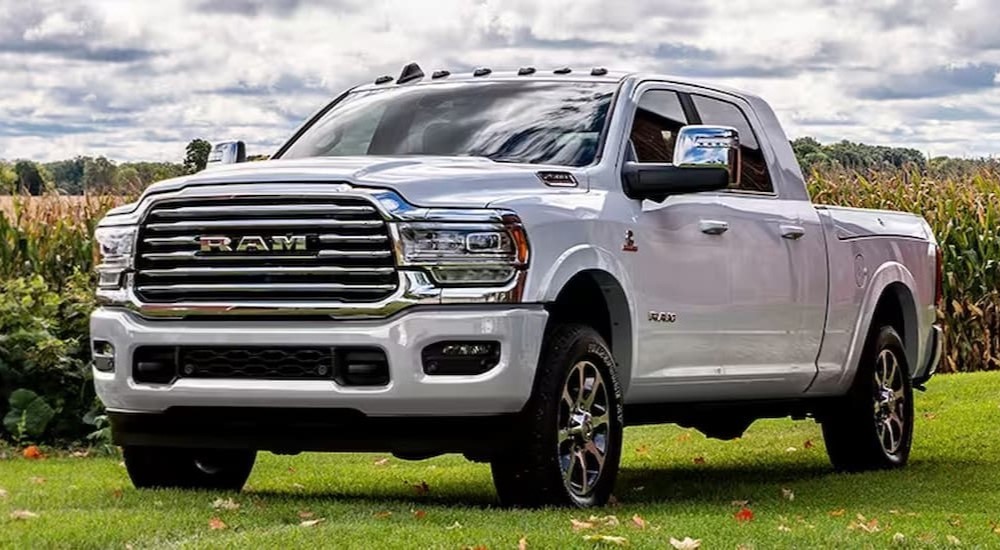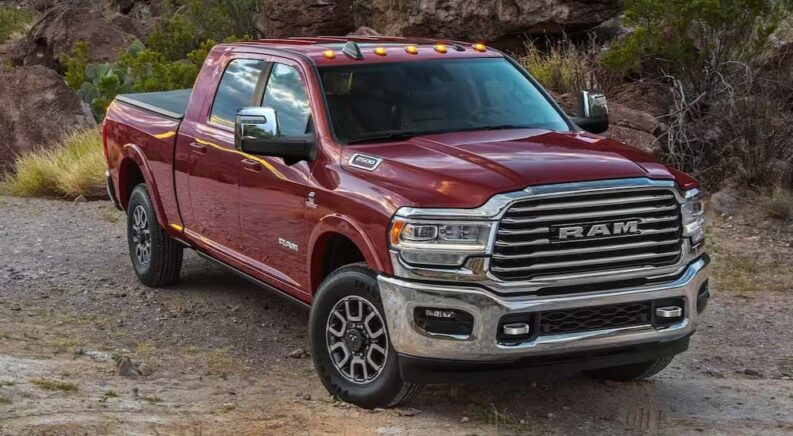Diesel and gas engines have a great deal in common, but there are also some key differences. Both diesel and gas engines use internal combustion to create power. Both employ pistons to drive a crankshaft to send power through the drivetrain and, ultimately, to the wheels. The main difference comes down to some specific steps in the internal combustion process. Designed with a higher compression ratio than their gas-fed cousins, diesel engines can initiate combustion without the use of a spark plug, relying on compression alone. This approach brings some distinct benefits when it comes to efficiency and torque, which is why diesels are often the go-to choice for some of the most demanding applications in the pickup world.
Of course, spark plugs, or lack thereof, aren’t the only difference between gas and diesel engines. If you’re in the market for a new, heavy-duty full-size pickup like a 2024 Ram 2500 for sale, deciding between gas and diesel is often one of the most consequential decisions in the buying process. While both versions of the popular pickup are up for any challenges that the road can throw at them, each excels in its own unique way. Picking the right tool for the job is just as important for your pickup as it is for your latest project, so before you leave the dealership with the wrong model, take a few minutes to study the key differences between diesel and gas engines.
Otto vs. Diesel Cycle
Gas and diesel engines not only use two different types of fuel, but they also use entirely different combustion cycles. Traditional gas-powered engines use a four-stage spark-ignition cycle known as the Otto cycle, which was developed by German engineer Nikolaus Otto in 1867. The Otto cycle consists of four steps that will be familiar to anyone who’s had to troubleshoot a stubborn engine: intake, compression, combustion/power, and exhaust. It all starts with air being drawn into the cylinder where it mixes with aerosolized fuel. Next, the piston rises within the cylinder, compressing the fuel/air mixture. Then comes the combustion phase, where the spark plug ignites the air/fuel mixture and creates a contained explosion that drives the piston back down into the cylinder. This is followed by the exhaust stage, where the waste gasses are expelled from the cylinder by the rising piston to make room for the next cycle to begin.
The diesel cycle, developed by Dr. Rudolph Diesel in 1897, consists of the same four steps, but with one important difference. Instead of using a spark plug to ignite the air/fuel mixture, the diesel cycle utilizes the sheer heat and pressure of the compressed air within the cylinder to ignite the fuel and air mixture. It might sound like a small detail, but it can make a world of difference when it comes to overall power and efficiency. The diesel cycle is what’s known as a compression-ignition cycle, while Otto’s process is referred to as a spark-ignition cycle.

Compression Ratio
You might be thinking a rather obvious question: Why is the fuel able to spontaneously ignite within a diesel engine without the help of a spark? As we alluded to above, it all comes down to compression. Diesel engines have a much higher compression ratio than gas-powered engines, often by as much as a two-to-one margin. In layman’s terms, an engine’s compression ratio describes the ratio between the volume of the cylinder when the piston is at its highest and lowest positions within the combustion chamber. A typical gas-powered engine will usually feature a compression ratio in the 8:1 to 12:1 range, while a diesel engine typically falls between 14:1 all the way up to 25:1. The higher this first number is, the less space between the top of the piston and the top of the cylinder during the compression stroke, which results in higher pressure within the combustion chamber. The higher the compression ratio, the more efficient an engine can be, which is why it’s hard to beat a diesel when you’re seeking to max out your MPG. Let’s use the 2024 Ram 2500 as an example. When optioned with the gasoline-powered 6.4L Hemi V8, the pickup manages a compression ratio of 10.0:1. Opting for the 6.7L Cummins turbo diesel increases that number to 19.0:1.
Horsepower and Torque
Horsepower and torque are often two of the primary considerations a driver will weigh before driving off the lot in a new pickup. In truth, these figures can vary widely, even on the same model, and much of that depends on whether there’s a gas or diesel engine under the hood.
If you’re looking for maximum horsepower, the gas engine is the way to go. This comes down less to the design of the gas engine and more to the fuel itself. Gas burns a lot faster than diesel, which means it’s able to produce more horsepower. Oddly, diesel actually packs more energy than an identical amount of gas, as much as 20 percent more, but its relatively slow combustion means that it can’t match a gas engine in terms of raw power. Again, let’s use the Ram 2500 as an example. The gas-powered 6.4L Hemi V8, producing 410 horsepower, is about 10 percent more powerful than the standard output 6.7L Cummins turbo diesel, producing 370.
More horsepower is nice, but it’s not always the be-all, end-all in the pickup world. Horsepower is helpful when trying to max out your top speed or win a drag race, but torque tends to be the metric by which hard-working trucks like the Ram 2500 are measured. When it comes to torque, diesels are king for a number of reasons. The increased compression ratio is a big factor, as is the relatively high energy density of diesel, but bore and stroke size are also important. In mathematical terms, torque equals force multiplied by distance. The longer stroke length of a diesel engine equates to more distance, resulting in more overall torque.
Lastly, there’s turbocharging. Diesels are often equipped with turbos as a means of increasing fuel efficiency, which also happens to create more torque. The torquey nature of diesel pickups is a big part of why they’re so often used for towing and hauling applications. The 6.7L Cummins turbo diesel gives drivers an impressive 850 ft-lb of torque, which is good enough for a 20,000-pound towing capacity and 3,160-pound payload capacity. Compare this to the standard Hemi V8 offering 429 lb-ft of torque, 17,540 pounds of towing capacity, and a 4,010 payload, and you’ll see just what we’re talking about.
Longevity
No matter whether they’re running on gas or diesel, modern pickup trucks like the 2024 Ram 2500 are some of the longest-lasting vehicles on the road today. According to one study, 2.2 percent of pickups will reach the all-important 200,000-mile mark on the odometer. That’s almost double the average of all other vehicle segments, with the longevity mostly being credited to the pickup’s heavy-duty construction. That said, those looking to maximize the longevity of their pickup should consider a diesel. There are a couple of reasons for this. Between 120,000 and 150,000 miles, gas-powered trucks tend to start experiencing significant wear on their cylinders, which can cause decreased efficiency along with a host of other performance-related issues. Diesel engines avoid this pitfall through the use of removable cylinder liners which can be replaced when the mileage creeps up and performance starts to suffer.
Then there’s the matter of RPMs. Diesel engines are all about maximizing torque at lower RPMs than gas engines, which means the engine will go through half as many RPMs during normal operation compared to a gas-powered vehicle. Fewer RPMs mean less wear and tear, which means more miles of worry-free driving. Diesel engines are also built of sturdier stuff than their gas-powered counterparts, with thicker casings and cylinder walls and higher-volume oiling systems. Combine these three factors and it’s easy to see why so many drivers turn to diesel engines when it comes time to find a truck that’s in it for the long haul.

Throttle Body
An engine’s throttle body, or lack thereof, is another major difference between gas and diesel engines. In a gas engine, stepping on the accelerator allows the throttle body to open, which allows more air to enter the engine. When the vehicle’s onboard computer senses this additional air rushing into the engine, it compensates by adding more fuel, maintaining the stoichiometric ratio and increasing power output. This differs from a diesel-powered vehicle where fuel, not air, is used to to throttle the engine. Diesel engines aren’t nearly as picky when it comes to keeping a consistent stoichiometric ratio. Add more fuel and the engine produces more power. Give it less fuel and it produces less.
Granted, this isn’t true of all diesel engines. Many of today’s diesel vehicles, including the 2024 Ram 2500, come with a throttle body for one simple reason: emissions. Many modern diesels use a technique known as Exhaust Gas Recirculation (EGR), which reduces emissions by reusing exhaust gas to power future combustion cycles. Some of the exhaust is rerouted, cooled, and fed back into the air intake system, which means less noxious gas escaping out the tailpipe. This EGR approach is a clever bit of engineering, but it requires a throttle body to create the sort of pressure differential needed to feed exhaust back into the engine. The throttle body also brings some advantages when it comes time to shut off the engine, preventing the sort of shaking that can take place when you power down a diesel.
When you consider the myriad advantages of a diesel, it’s little wonder that the engine has become such a popular choice in today’s pickup segment. From increased torque and longevity to efficiency, emissions, and more, a diesel pickup is an alluring option for any driver who’s prone to putting their pickup through its paces. That’s not to say a diesel engine is the right choice for every driver in every driving situation. If you spend a lot of time traveling on the highway, carrying heavier payloads rather than towing them, or just enjoy going fast, a gas-powered truck might be the right choice due to the increased horsepower. But the jump in torque is often one of the most compelling reasons to choose a diesel, especially for those who see a lot of towing, hauling, or off-road adventure in their future. The low-end torque offered by a diesel engine can make all the difference when it comes to climbing a steep hill with a loaded-down trailer or freeing yourself from a sticky situation on the trail. Make sure to consider what sort of truck-based antics you’ll be getting up to before making your purchase.

